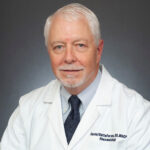The shortage of rheumatologists in rural areas has been well established, but Dr. Battafarano drove home exactly how severe the problem is. In the Northwest, Southwest and South-Central regions of the U.S., more than 97% practice in a metropolitan statistical area or an urban area that has a relatively high population, at least about 60,000 people.
In the South-Central region of Arkansas, Oklahoma and north Texas, enrollment in Medicare Advantage—which can help get patients the care they need—is just 43%. Other challenges are that nurse practitioners are not common in the region and that most hospitals in the region are for-profit hospitals, which tend to provide less support for specialties like rheumatology, Dr. Battafarano said.
Fellowship programs and medical schools are almost exclusively located in urban areas in this region, he noted.
“So Texas may have rheumatologists, but it depends on where you live,” he said. If you live in Laredo, for example, you have a 2.5-hour drive to see a rheumatologist.
Pediatric rheumatologists are even more scarce.
“I’m in San Antonio—we don’t have a pediatric rheumatologist in San Antonio, the seventh-largest city in the United States,” he said, adding that very few adult rheumatologists see children, in part due to low volume and medication risks.
“As we look at our workforce, we’re trying to look at it coming down and drilling down to data in regions and states, and payers and hospitals and potential for GME (graduate medical education)—and, by the way, quality of life, burnout,” he said. “We need to build teams of people, not have anybody in solo practice who’s going to be vulnerable to burnout.”
Intervention Teams
The committee has created five intervention teams tackling distinct aspects of the workforce problem.
One team is covering the support of fellowship positions and training of providers, setting out to enhance fellowship training opportunities, promote early exposure to the field, and the consideration of a two-year pediatric rheumatology fellowship.
A second is covering recruitment, including establishing benchmarks for recruiting, along with incentives and loan repayment, creating end-of-career stepdowns to extend an aging workforce and providing financial support for telehealth and multistate licensing.
A third is dedicated to fostering patient-centered communities, facilitating an education summit with private or third-party payers and public payers, developing value-based payment arrangements and coordinating population health management strategies.
A fourth is devoted to virtual training programs for development and training for fellows, advanced practice providers and non-rheumatologists, and to help with training of primary care physicians and other providers on musculoskeletal and clinical rheumatology topics.



